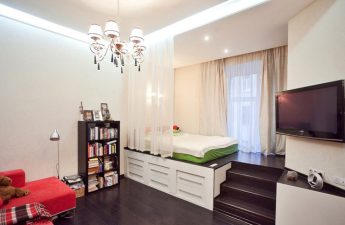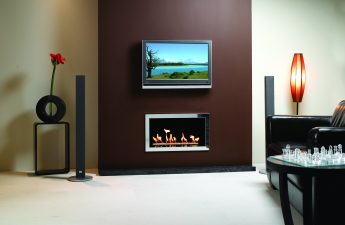When thinking about DIY interior design,Most people dream of a home that is cozy, beautiful and unique. It should be taken into account that the formation of any space is conventionally divided into the following stages:
- definition of functional zones;
- choice of prevailing materials;
- selection of color solutions;
- decoration of the room with various accessories.
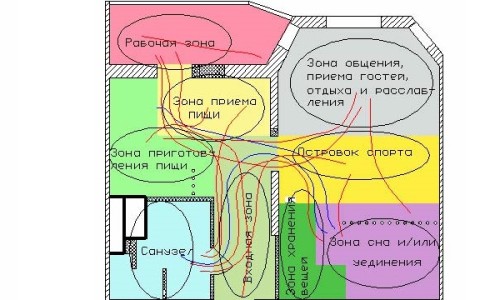 Zoning of apartment space. To create a stylish, comfortable and functional space, professional designers use the techniques discussed below.
Zoning of apartment space. To create a stylish, comfortable and functional space, professional designers use the techniques discussed below.
Style and color in the interior
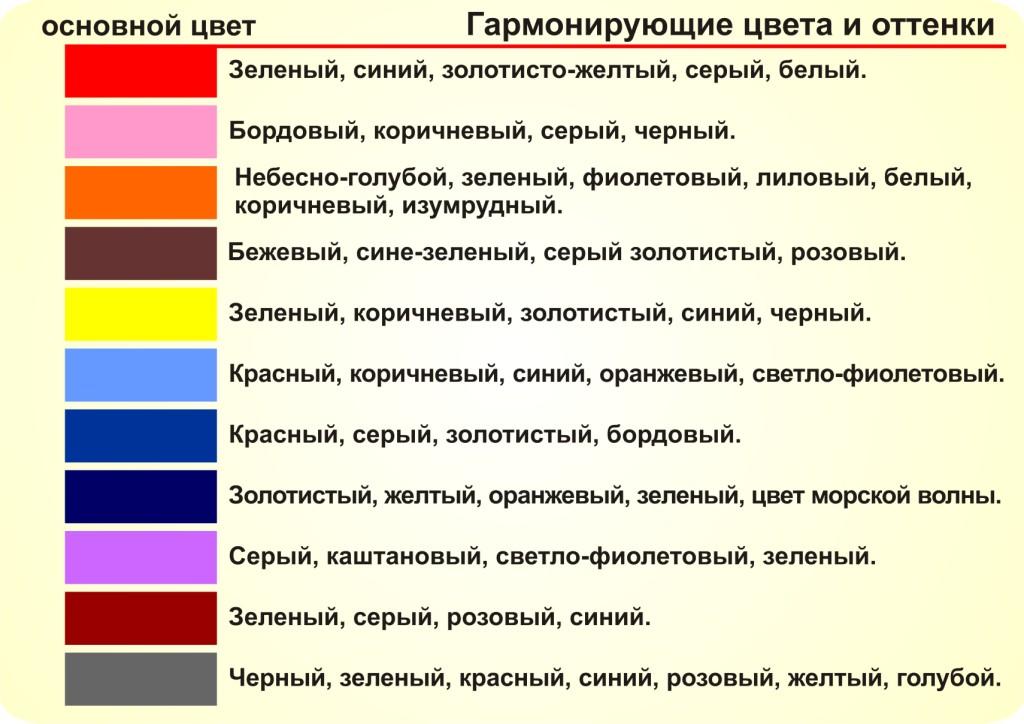 Table of harmonious color combinations ininterior. When choosing a stylistic and color scheme, it is necessary to determine the functional needs of the residents. As a result, the apartment is divided into a kitchen, dining, work and other zones. It is very important to feel the most comfortable and pleasing to the eye color scheme. The main ideas and color of the interior will have a significant impact on well-being in the future. Accessories can be replaced at any time, and repainting the walls and remodeling the space will require significant financial, time and moral costs. Most people prefer to use neutral beige shades in the interior, but sometimes the choice of color scheme has a number of features and is individual for different psychotypes. For example, the stimulating effect of red on a person's emotional state is well known. But for a choleric person, a long stay in a room with a red color scheme is fraught with overexertion, but red tones in the work area will have a positive "invigorating" effect on a melancholic person. The color of the flooring should be chosen no less carefully. All shades of blue underfoot do not encourage staying in the room for a long time; you want to leave it as quickly as possible. Yellow tones add cheerfulness and sunlight to the atmosphere, but do not visually provide a feeling of reliable support. Return to contents</a>
Table of harmonious color combinations ininterior. When choosing a stylistic and color scheme, it is necessary to determine the functional needs of the residents. As a result, the apartment is divided into a kitchen, dining, work and other zones. It is very important to feel the most comfortable and pleasing to the eye color scheme. The main ideas and color of the interior will have a significant impact on well-being in the future. Accessories can be replaced at any time, and repainting the walls and remodeling the space will require significant financial, time and moral costs. Most people prefer to use neutral beige shades in the interior, but sometimes the choice of color scheme has a number of features and is individual for different psychotypes. For example, the stimulating effect of red on a person's emotional state is well known. But for a choleric person, a long stay in a room with a red color scheme is fraught with overexertion, but red tones in the work area will have a positive "invigorating" effect on a melancholic person. The color of the flooring should be chosen no less carefully. All shades of blue underfoot do not encourage staying in the room for a long time; you want to leave it as quickly as possible. Yellow tones add cheerfulness and sunlight to the atmosphere, but do not visually provide a feeling of reliable support. Return to contents</a>
Methods of expanding space
 Using horizontal or vertical stripesyou can change the perception of the space of the room. You can change the perception of space using the texture of finishing materials and the correct selection of interior items. Using horizontal stripes, you can visually expand the room and reduce its height. Vertical division, on the contrary, will increase the height of the ceilings and visually compress the room. Mirror and glossy surfaces, light shades are classic techniques for creating the optical illusion of a volumetric room. Suspended ceilings and backlighting in the ceiling area visually increase the height of the room. The same effect is achieved by painting the floor in a rich color or giving it a varnish surface. The opposition of vertical and horizontal enclosing planes and contrasting textures contributes to the visual expansion of the horizon. A feeling of freedom in a small room arises when using light cool tones, such as gray-blue, pearl, pale green. Return to contents</a>Popular techniques when playing with room configuration
Using horizontal or vertical stripesyou can change the perception of the space of the room. You can change the perception of space using the texture of finishing materials and the correct selection of interior items. Using horizontal stripes, you can visually expand the room and reduce its height. Vertical division, on the contrary, will increase the height of the ceilings and visually compress the room. Mirror and glossy surfaces, light shades are classic techniques for creating the optical illusion of a volumetric room. Suspended ceilings and backlighting in the ceiling area visually increase the height of the room. The same effect is achieved by painting the floor in a rich color or giving it a varnish surface. The opposition of vertical and horizontal enclosing planes and contrasting textures contributes to the visual expansion of the horizon. A feeling of freedom in a small room arises when using light cool tones, such as gray-blue, pearl, pale green. Return to contents</a>Popular techniques when playing with room configuration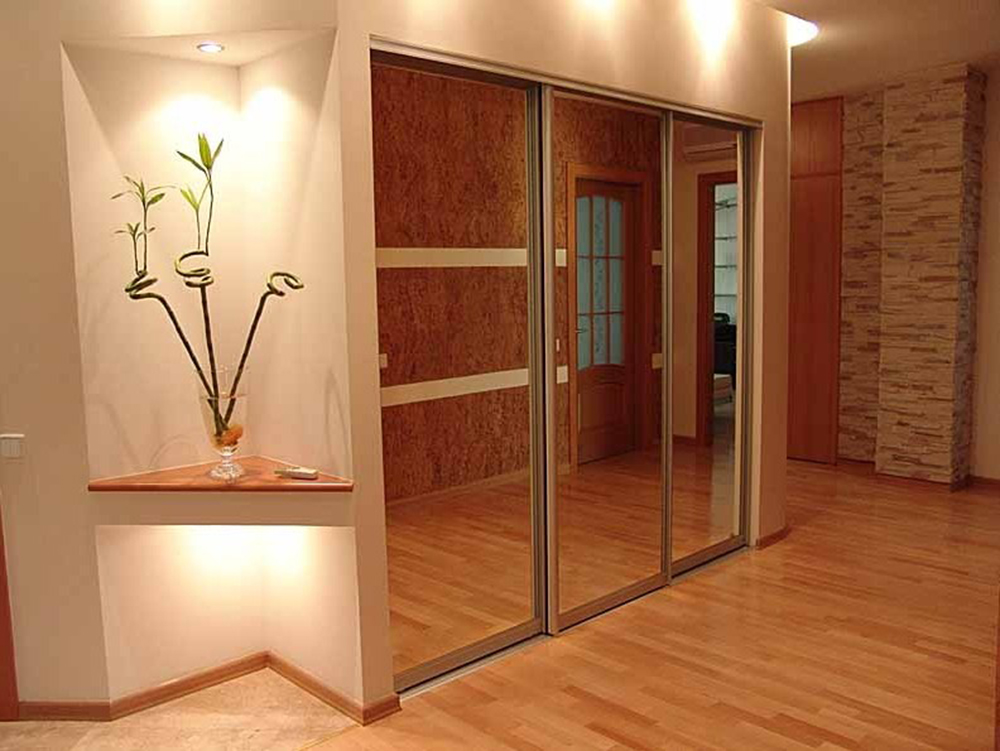 Built-in wardrobes, niches and shelves will add tointerior airiness and purity of lines. You can give an elongated room the shape of the desired square by placing mirrors from floor to ceiling along the long wall, observing certain intervals. To visually increase the height of the ceiling, you can use a contrasting, relative to the main background, vertical stripe on the wallpaper. The same effect is achieved by glazing narrow vertical niches with frosted glass from floor to ceiling with hidden lighting. The effect will be enhanced by glossy floor or ceiling coverings, which will be reflected on adjacent surfaces. A current interior idea is the hidden placement of objects and equipment. This helps to add more airiness to the interior and maintain purity of lines. Niches, built-in cabinets, dressing rooms, storage systems can be hidden behind doors, equally decorated with the entire surface of the wall. Sometimes the door leaf can be deliberately highlighted, turning it into an additional accessory, for example, with the help of frescoes. Return to contents</a>
Built-in wardrobes, niches and shelves will add tointerior airiness and purity of lines. You can give an elongated room the shape of the desired square by placing mirrors from floor to ceiling along the long wall, observing certain intervals. To visually increase the height of the ceiling, you can use a contrasting, relative to the main background, vertical stripe on the wallpaper. The same effect is achieved by glazing narrow vertical niches with frosted glass from floor to ceiling with hidden lighting. The effect will be enhanced by glossy floor or ceiling coverings, which will be reflected on adjacent surfaces. A current interior idea is the hidden placement of objects and equipment. This helps to add more airiness to the interior and maintain purity of lines. Niches, built-in cabinets, dressing rooms, storage systems can be hidden behind doors, equally decorated with the entire surface of the wall. Sometimes the door leaf can be deliberately highlighted, turning it into an additional accessory, for example, with the help of frescoes. Return to contents</a>
Interior design by own hands: various styles
 The high-tech style is characterized bymultifunctionality and high technology, it has a lot of metal, chrome and glass. Interior design ideas are striking in their diversity. At the same time, modern design distinguishes several main styles and substyles, which have their own distinctive features and characteristic specifics. The main styles include:
The high-tech style is characterized bymultifunctionality and high technology, it has a lot of metal, chrome and glass. Interior design ideas are striking in their diversity. At the same time, modern design distinguishes several main styles and substyles, which have their own distinctive features and characteristic specifics. The main styles include:
- high tech;
- minimalism;
- modernism;
- postmodernism;
- The styles of different countries and peoples (Greece, Japan, Scandinavia, Italy).
The main difference of the high-tech style iscompliance with 3 basic principles. The space should be multifunctional, simple and high-tech. The combination of metal, chrome and glass, straight lines and geometric shapes - these are the main components of high-tech. Light-colored wallpaper, smooth plaster, paint, abstraction are used in wall decoration. Ceilings are most often stretch or plasterboard, representing a complex structure. Glossy laminate, linoleum, ceramic tiles, parquet boards, self-leveling floors are used for flooring. Minimalism allows you to create a beautiful and cozy home without excess and glamor.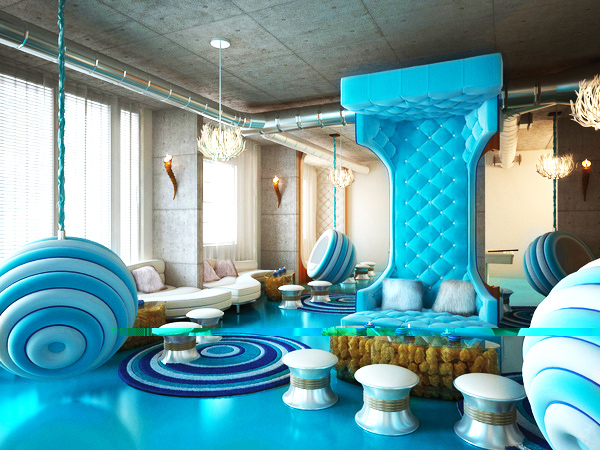 Postmodernism is big, spacious, brighthalls with original unusual designs This idea implies a large amount of free space with a minimum of furniture. The interior decoration is done in light monochromatic tones (white, blue, gray). Minimalism implies a complete absence of accessories. Furniture should be chosen from glass, wood, leather. Modernism has a special originality and uniqueness. It is used to create bright and unique interiors, but it is not suitable for everyone. Acid shades, a symbiosis of various patterns and designs, furniture of ambiguous shapes - these are the distinctive features of modernism. Postmodernism is characterized by bright, energetic colors, as well as beige, silver, metallic, mother-of-pearl, fluorescent shades. Dynamic, free lines go well with a variety of textures and patterns. In lighting, it is possible to combine different types of lamps, for example, large chandeliers with halogen and neon backlighting. Postmodernism - These are large, spacious halls with light original structures (prefabricated and collapsible, light aluminum and traditional reinforced concrete, arched, beam and cable-stayed). The decor is characterized by contrasting texture and texture combinations, the use of artificial leather, nickel-plated and chrome-plated materials. The windows are spacious, sometimes the entire wall, sliding, folding, hinged and pivoting, telescopic, sliding, folding, swinging, balancing, revolving doors. The concept of styles of different countries and peoples includes all the ideas of interiors that got their names from the names of countries. At the same time, each room has its own thematic focus. For example, natural materials are in great demand in Japan. Bamboo wallpaper, wicker furniture, natural textiles help to achieve an indescribable feeling of comfort and tranquility. To create an interior in the Japanese style, it is preferable to use wood, bamboo, natural stone, rice paper and straw. The interior decoration should be done in a warm, calm range.
Postmodernism is big, spacious, brighthalls with original unusual designs This idea implies a large amount of free space with a minimum of furniture. The interior decoration is done in light monochromatic tones (white, blue, gray). Minimalism implies a complete absence of accessories. Furniture should be chosen from glass, wood, leather. Modernism has a special originality and uniqueness. It is used to create bright and unique interiors, but it is not suitable for everyone. Acid shades, a symbiosis of various patterns and designs, furniture of ambiguous shapes - these are the distinctive features of modernism. Postmodernism is characterized by bright, energetic colors, as well as beige, silver, metallic, mother-of-pearl, fluorescent shades. Dynamic, free lines go well with a variety of textures and patterns. In lighting, it is possible to combine different types of lamps, for example, large chandeliers with halogen and neon backlighting. Postmodernism - These are large, spacious halls with light original structures (prefabricated and collapsible, light aluminum and traditional reinforced concrete, arched, beam and cable-stayed). The decor is characterized by contrasting texture and texture combinations, the use of artificial leather, nickel-plated and chrome-plated materials. The windows are spacious, sometimes the entire wall, sliding, folding, hinged and pivoting, telescopic, sliding, folding, swinging, balancing, revolving doors. The concept of styles of different countries and peoples includes all the ideas of interiors that got their names from the names of countries. At the same time, each room has its own thematic focus. For example, natural materials are in great demand in Japan. Bamboo wallpaper, wicker furniture, natural textiles help to achieve an indescribable feeling of comfort and tranquility. To create an interior in the Japanese style, it is preferable to use wood, bamboo, natural stone, rice paper and straw. The interior decoration should be done in a warm, calm range.
